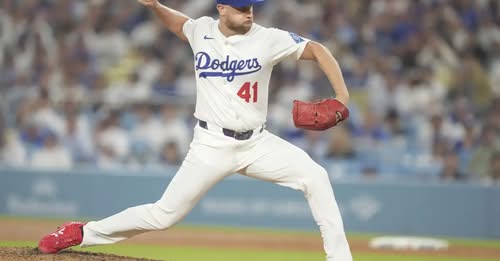The Los Angeles Dodgers, a franchise known for its strategic maneuvering and deep pockets, often make significant moves at the trade deadline to bolster their roster for a postseason push. Over the years, they have become synonymous with acquiring high-profile stars and impactful pieces, often shaking up the baseball landscape with blockbuster trades that send shockwaves through the league. However, in the recent trade deadline window, the Dodgers made a noticeably conservative move in terms of pitching help, acquiring Brock Stewart as their sole pitching addition aimed at providing immediate impact.
This move was intriguing given the Dodgers’ perennial status as one of the league’s best teams and their ever-present ambition to claim another World Series title. The team’s pitching staff, historically one of their greatest strengths, faced some challenges heading into the deadline. Injuries, inconsistent performances, and workload concerns created an environment where adding depth and reliable arms seemed prudent. Yet, the Dodgers’ front office chose to tread carefully, opting to bring in Brock Stewart—a pitcher with a particular profile that fit their needs without shaking up the roster dramatically.
Brock Stewart’s journey to this point has been one of perseverance and adaptability. Not a household name or a frontline ace, Stewart has built a reputation as a solid, versatile pitcher capable of filling multiple roles. Originally drafted by the Dodgers in the 2011 draft, Stewart’s career path has been marked by moments of promise, struggles with consistency, and a willingness to evolve. Over time, he developed into a valuable bullpen arm who could also spot-start when needed. His ability to contribute in varied roles made him an attractive piece for a team like the Dodgers, who value flexibility in their pitching staff.
The acquisition itself was a reflection of the Dodgers’ broader philosophy at the deadline: enhancing depth while maintaining roster stability. The Dodgers could have chased bigger names or more high-profile pitchers in the trade market, but they opted instead for a pragmatic addition. Stewart’s presence in the clubhouse and on the mound would provide a reliable option for manager Dave Roberts, who often leverages matchups and strategic bullpen usage to optimize outcomes. Stewart’s experience and knowledge of the Dodgers’ system made him a seamless fit, minimizing disruption while maximizing value.
Looking closely at the Dodgers’ pitching situation before the trade, it becomes clear why Stewart’s addition was sensible. The starting rotation, anchored by the likes of Clayton Kershaw and Walker Buehler, was solid but not immune to wear and tear. Kershaw, while still effective, was managing innings carefully, and Buehler was coming back from injury. The middle of the rotation featured a mix of younger arms and veterans, some of whom had shown flashes of brilliance but lacked consistency. Injuries had thinned out the depth, and the bullpen had been taxed heavily in key moments throughout the first half of the season.
In such a scenario, adding a mid-rotation or multi-inning bullpen arm capable of bridging the gap between starters and late-inning relievers was a priority. Brock Stewart fit this mold perfectly. His ability to eat innings, start or relieve as the team required, and keep hitters off balance with a diverse pitch arsenal made him an ideal candidate to stabilize the pitching staff during the stretch run. Moreover, Stewart’s familiarity with the Dodgers’ pitching philosophy and coaching staff meant that he could step in without a long adjustment period, an important consideration in the heat of a playoff race.
Financially, the move was also a low-risk proposition. Unlike costly acquisitions involving large contracts or expensive prospects, Stewart came at a manageable price. This allowed the Dodgers to preserve flexibility not only in terms of roster composition but also payroll. Maintaining financial flexibility is critical for a team like Los Angeles, who regularly balance spending on star players with investing in depth and future talent. Stewart’s acquisition represented a smart use of resources—filling a need efficiently without compromising the team’s broader strategic goals.
The timing of the trade was also notable. Occurring near the trade deadline, the move came at a juncture when many teams are scrambling to address glaring weaknesses or put the finishing touches on their rosters. By waiting until the deadline, the Dodgers could fully assess their team’s health and performance and make a measured decision. The addition of Stewart signaled confidence in the existing pitching staff while recognizing the necessity of adding a piece who could provide immediate help and insurance against further injuries or underperformance.
Brock Stewart’s pitching style also meshed well with the Dodgers’ analytical approach to pitching. Known for his command and ability to mix pitches effectively, Stewart can generate ground balls and induce weak contact, traits that align with the Dodgers’ emphasis on controlling the ball and limiting big innings. His ability to keep runners off base and manage high-leverage situations contributes to the team’s overall stability on the mound. Furthermore, Stewart’s veteran presence lends intangible benefits, such as mentoring younger pitchers and maintaining composure in pressure situations, which can be invaluable in the playoff atmosphere.
From a clubhouse perspective, Stewart’s return to the Dodgers brought a familiar face into a team culture defined by professionalism and competitive drive. His past tenure with the Dodgers had established relationships and trust with teammates and coaches. Such continuity fosters a positive environment conducive to success, particularly during the demanding stretch of the regular season and postseason. The importance of clubhouse chemistry should not be underestimated, and Stewart’s integration was smooth and welcomed.
Looking at the broader trade deadline landscape, the Dodgers’ choice to make only one immediate pitching addition stands out. Many contending teams aggressively sought to overhaul their pitching staffs, often acquiring multiple arms to address glaring weaknesses. The Dodgers, by contrast, demonstrated a level of confidence in their core group and a willingness to work through challenges with minimal disruption. This approach reflects the team’s philosophy of building a strong, deep roster through a combination of homegrown talent, targeted trades, and careful management of player health and performance.
The Brock Stewart acquisition also highlights the Dodgers’ long-term vision. While the move was designed to provide short-term help, it also fit into a broader strategy of maintaining organizational depth. By acquiring a pitcher who could be a reliable option in multiple roles, the Dodgers ensured that their pitching resources would be well-distributed, reducing the risk of overreliance on any single arm. This balance is crucial for a team with championship aspirations, where managing fatigue and avoiding injury are critical components of success.
Critically, Stewart’s presence on the roster allowed the Dodgers to be more flexible with their bullpen usage. In previous seasons, overworking key relievers in high-leverage spots sometimes led to diminished effectiveness in the postseason. With Stewart’s availability, the Dodgers could better stagger workloads, preserving their best arms for crucial moments while still maintaining effective innings from middle relief. This strategic depth gave manager Dave Roberts more options and tactical versatility—an often underrated but vital advantage in the postseason.
As the Dodgers pushed toward the playoffs, the acquisition of Brock Stewart was a testament to the front office’s commitment to building a complete team rather than chasing headline-grabbing trades. In an era where big splashy moves often dominate the conversation, the Dodgers reminded the baseball world that sometimes the smartest move is to add a reliable, versatile piece who can quietly contribute to a championship run. Stewart’s ability to provide immediate help in a variety of roles underscored the team’s depth and adaptability, qualities that have defined the Dodgers’ success in recent years.
Looking ahead, the impact of Stewart’s addition would be measured not just by his statistical output but also by how he helped stabilize the pitching staff and supported the team’s overall balance. His presence freed up other pitchers to perform at their best and reduced the risk of fatigue-related issues down the stretch. The Dodgers’ calculated approach, centered around this single but significant pitching addition, exemplified their commitment to sustained excellence and strategic roster management.
In conclusion, the Dodgers’ acquisition of Brock Stewart at the trade deadline as their lone immediate pitching addition was a move marked by pragmatism, foresight, and confidence. Stewart’s versatility, experience, and familiarity with the organization made him an ideal fit to address the Dodgers’ pitching needs without disrupting the team’s core dynamic. This transaction reinforced the Dodgers’ reputation as a team that balances star power with depth, managing resources efficiently while maintaining championship aspirations. As the postseason approached, Stewart’s role, though not headline-grabbing, was a crucial cog in the Dodgers’ pursuit of another World Series title—proof that sometimes, the best moves are the ones that fly under the radar but deliver significant impact when it matters most.



